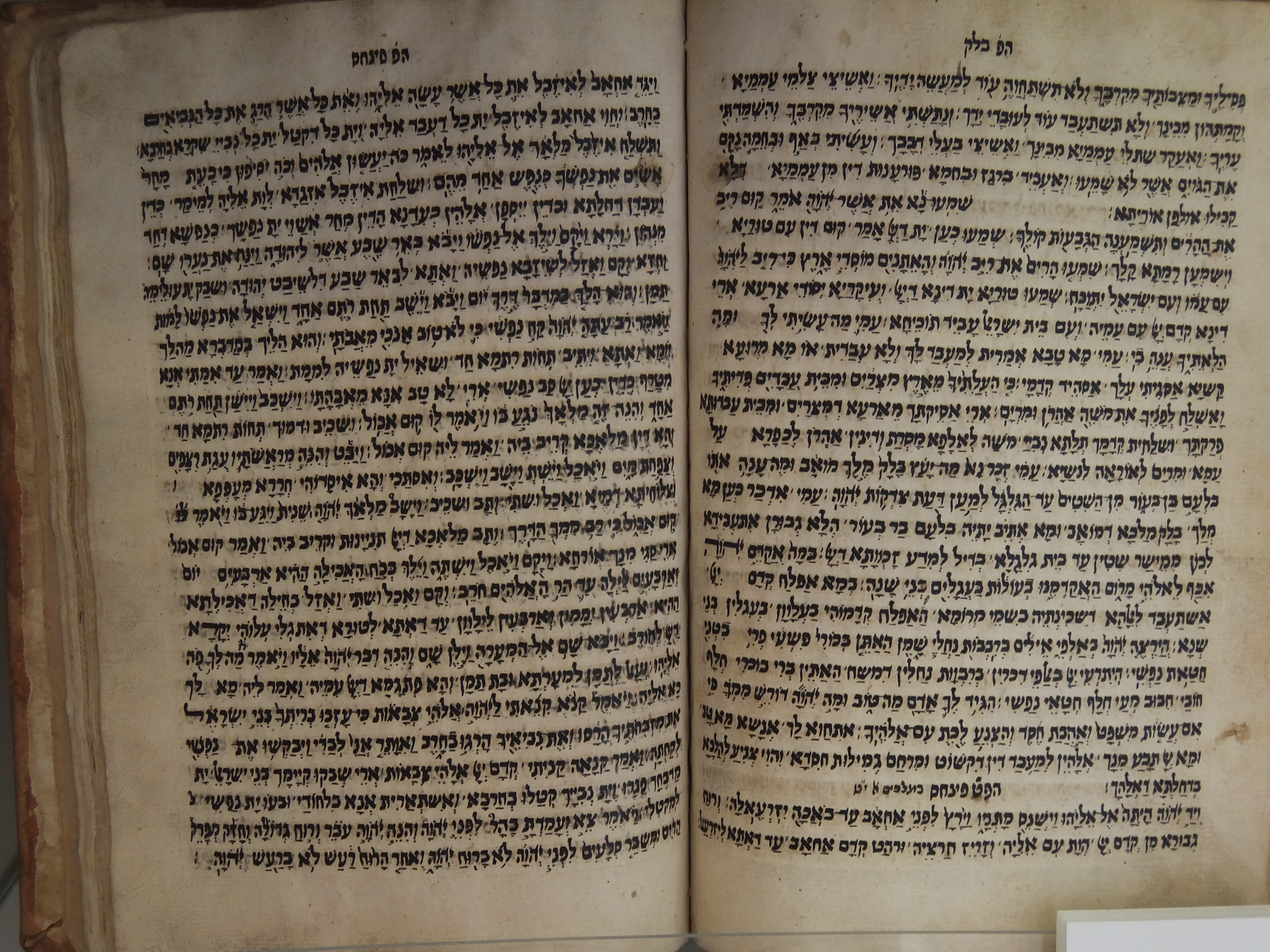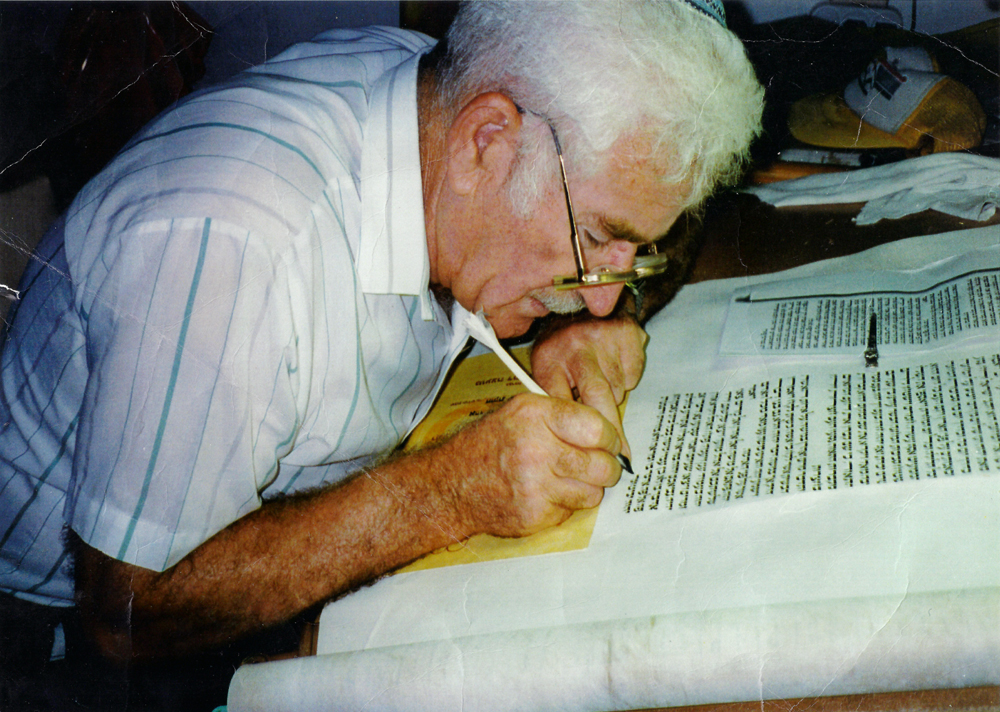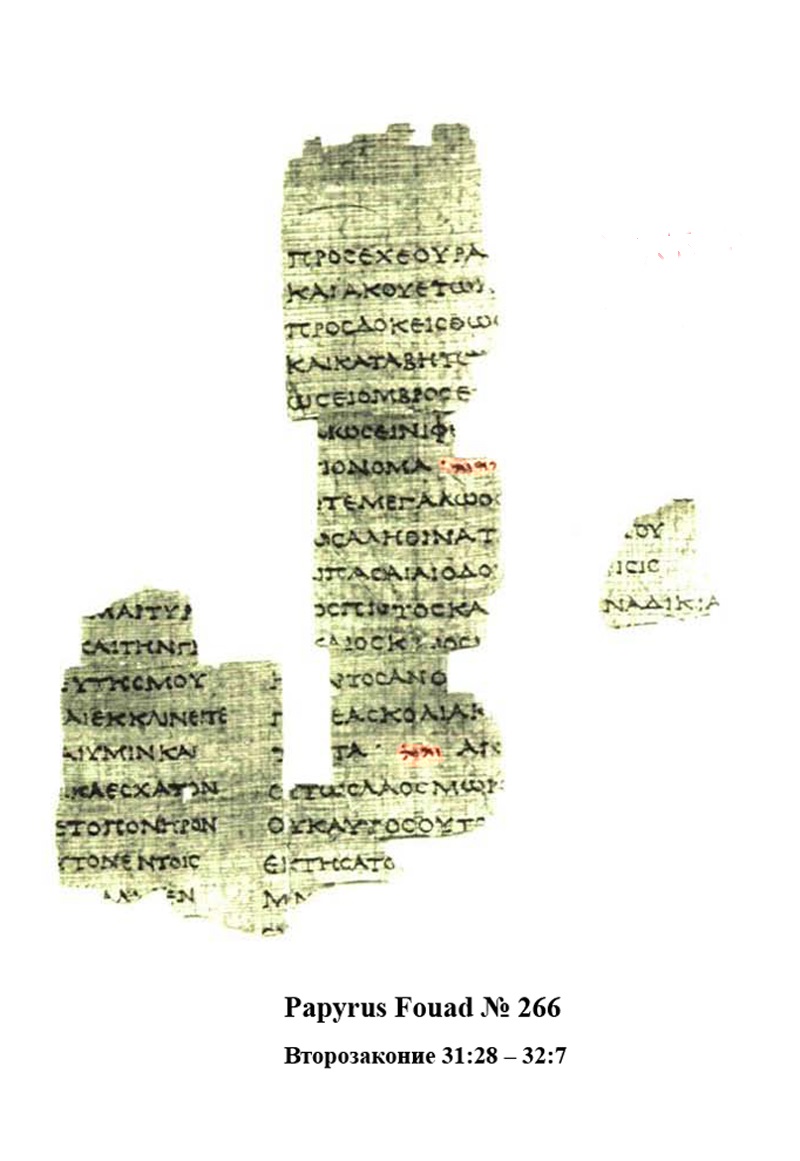|
Soferim
A sofer, sopher, sofer SeTaM, or sofer ST"M (, "scribe"; plural , ) is a Jewish scribe who can transcribe Sifrei Kodesh (holy scrolls), tefillin (phylacteries), mezuzot (ST"M, , is an abbreviation of these three terms) and other religious writings. Description Soferim are men who are trained and permitted to transcribe Jewish texts according to the laws of Judaism: * Sefer torah, a complete copy of Torah read by Jewish men during prayer. * Tefillin, scrolls of Torah verses worn by Jewish adults during prayer. * Mezuzot, scrolls of Torah verses placed on the doors of Jewish households. collectively known as ST"M. By simple definition, soferim are copyists, but their religious role in Judaism is much more. Besides sifrei Torah, tefillin, and mezuzot, scribes are necessary to write the Five Megillot (scrolls of the Song of Songs, Book of Ruth, Book of Esther, Ecclesiastes, and Book of Lamentations), Nevi'im (the books of the prophets, used for reading the haftarah), and for ... [...More Info...] [...Related Items...] OR: [Wikipedia] [Google] [Baidu] |
Soferim (Talmud)
''Masekhet Soferim'' (), the "Tractate of the Scribes", is a non-canonical Talmudic tractate dealing especially with the rules relating to the Sofer, preparation of holy books, as well as with the laws of Torah reading. One of the minor tractates, it is generally thought to have originated in eighth-century Land of Israel. Being of late and uncertain date, it is now generally printed as Talmudic addenda. Chapters Soferim consists of 21 chapters, containing 225 paragraphs ("halakhot") in all. The chapters may be summarized as follows: :1: On parchment and other writing-material; language, and translation of the Jewish Scriptures; the Septuagint; persons who are qualified to prepare books; leaves and pages; open and closed paragraphs. :2: Spaces between letters, words, lines, pages, and books; space-lines; number of columns to the leaf, and lines to the column; width and height of the scrolls; rollers; sewing; mending; final letters. :3: Writing several books on a single scroll ... [...More Info...] [...Related Items...] OR: [Wikipedia] [Google] [Baidu] |
Haftarah
The ''haftara'' or (in Ashkenazi Jews, Ashkenazic pronunciation) ''haftorah'' (alt. ''haftarah, haphtara'', ) "parting," "taking leave" (plural form: ''haftarot'' or ''haftoros''), is a series of selections from the books of ''Nevi'im'' ("Prophets") of the Hebrew Bible (''Tanakh'') that is publicly read in synagogue as part of Judaism, Jewish religious practice. The ''haftara'' reading follows the Torah reading on each Shabbat, Sabbath and on Jewish holidays, Jewish festivals and ta'anit, fast days. Typically, the ''haftara'' is thematically linked to the ''parashah'' (weekly Torah portion) that precedes it. The ''haftara'' is sung in a chant. (Chanting of Biblical texts is known as "ta'amim" in Hebrew, "''trope''" in Yiddish, or "Hebrew cantillation, cantillation" in English.) Related blessings precede and follow the haftara reading. The origin of haftara reading is lost to history, and several theories have been proposed to explain its role in Jewish practice, suggesting ... [...More Info...] [...Related Items...] OR: [Wikipedia] [Google] [Baidu] |
Talmud
The Talmud (; ) is the central text of Rabbinic Judaism and the primary source of Jewish religious law (''halakha'') and Jewish theology. Until the advent of Haskalah#Effects, modernity, in nearly all Jewish communities, the Talmud was the centerpiece of Jewish culture, Jewish cultural life and was foundational to "all Jewish thought and aspirations", serving also as "the guide for the daily life" of Jews. The Talmud includes the teachings and opinions of thousands of rabbis on a variety of subjects, including halakha, Jewish ethics, Jewish philosophy, philosophy, Jewish customs, customs, Jewish history, history, and Jewish folklore, folklore, and many other topics. The Talmud is a commentary on the Mishnah. This text is made up of 63 Masekhet, tractates, each covering one subject area. The language of the Talmud is Jewish Babylonian Aramaic. Talmudic tradition emerged and was compiled between the destruction of the Second Temple in 70 CE and the Arab conquest in the early seve ... [...More Info...] [...Related Items...] OR: [Wikipedia] [Google] [Baidu] |
Sefer Torah
file:SeferTorah.jpg, A Sephardic Torah scroll rolled to the first paragraph of the Shema file:Köln-Tora-und-Innenansicht-Synagoge-Glockengasse-040.JPG, An Ashkenazi Torah scroll rolled to the Decalogue file:Keneseth Eliyahoo Synagogue, Interior, Tora Cases.jpg, Torah cases at Knesset Eliyahoo, Knesset Eliyahoo Synagogue, Mumbai, India A Torah scroll (, , lit. "Book of Torah"; plural: ) is a manuscript, handwritten copy of the Torah, meaning the five books of Moses (the first books of the Hebrew Bible). The Torah scroll is mainly used in the ritual of Torah reading during Jewish prayers. At other times, it is stored in the holiest spot within a synagogue, the Torah ark, which is usually an ornate curtained-off cabinet or section of the synagogue built along the wall that most closely faces Jerusalem, the Mizrah, direction Jews face when Jewish prayer, praying. The text of the Torah is also commonly printed and bookbinding, bound in codex, book form for non-ritual functions ... [...More Info...] [...Related Items...] OR: [Wikipedia] [Google] [Baidu] |
Torah Scribe
The Torah ( , "Instruction", "Teaching" or "Law") is the compilation of the first five books of the Hebrew Bible, namely the books of Genesis, Exodus, Leviticus, Numbers and Deuteronomy. The Torah is also known as the Pentateuch () or the Five Books of Moses. In Rabbinical Jewish tradition it is also known as the Written Torah (, ). If meant for liturgic purposes, it takes the form of a Torah scroll ( ''Sefer Torah''). If in bound book form, it is called '' Chumash'', and is usually printed with the rabbinic commentaries (). In rabbinic literature, the word ''Torah'' denotes both the five books ( "Torah that is written") and the Oral Torah (, "Torah that is spoken"). It has also been used, however, to designate the entire Hebrew Bible. The Oral Torah consists of interpretations and amplifications which according to rabbinic tradition have been handed down from generation to generation and are now embodied in the Talmud and Midrash. Rabbinic tradition's understandi ... [...More Info...] [...Related Items...] OR: [Wikipedia] [Google] [Baidu] |
Calligraphy
Calligraphy () is a visual art related to writing. It is the design and execution of lettering with a pen, ink brush, or other writing instruments. Contemporary calligraphic practice can be defined as "the art of giving form to signs in an expressive, harmonious, and skillful manner". In East Asia and the Islamic world, where written forms allow for greater flexibility, calligraphy is regarded as a significant art form, and the form it takes may be affected by the meaning of the text or the individual words. Modern Western calligraphy ranges from functional inscriptions and designs to fine-art pieces where the legibility of letters varies. Classical calligraphy differs from type design and non-classical hand-lettering, though a calligrapher may practice both. CD-ROM Western calligraphy continues to flourish in the forms of wedding invitations and event invitations, font design and typography, original hand-lettered logo design, religious art, announcements, graphic des ... [...More Info...] [...Related Items...] OR: [Wikipedia] [Google] [Baidu] |
Rabbi
A rabbi (; ) is a spiritual leader or religious teacher in Judaism. One becomes a rabbi by being ordained by another rabbi—known as ''semikha''—following a course of study of Jewish history and texts such as the Talmud. The basic form of the rabbi developed in the Pharisees, Pharisaic (167 BCE–73 CE) and Talmudic (70–640 CE) eras, when learned teachers assembled to codify Judaism's written and oral laws. The title "rabbi" was first used in the first century CE. In more recent centuries, the duties of a rabbi became increasingly influenced by the duties of the Clergy, Protestant Christian minister, hence the title "pulpit rabbis." Further, in 19th-century Germany and the United States, rabbinic activities such as sermons, pastoral counseling, and representing the community to the outside all increased in importance. Within the various Jewish denominations, there are different requirements for rabbinic ordination and differences in opinion regarding who is recognized as a ... [...More Info...] [...Related Items...] OR: [Wikipedia] [Google] [Baidu] |
The Mitzvah To Write A Torah Scroll
The mitzvah to write a Torah scroll () is the second to last mitzvah of the 613 Jewish commandments. It mandates Jews to write a Torah scroll for themselves. The source of the mitzvah is from what is said in Parashat Vayelech in Book of Deuteronomy: In the Oral Torah it is said that although according to the verse only the parasha "Hazinu" should be written, but since it is forbidden to write only one parsha from the Torah, necessarily the intention of the Torah in this mitzvah is to write the whole Torah. Purpose The mitzvah was given for two reasons, the first is that in writing the Torah in ink on the parchment there is a continuation of the tradition of Israel, and the passing on of the testimony of "the event of Mount Sinai". The second reason is so that Torah scrolls are in the hands of every person in Israel, and anyone who wants to study them will be able to do so. Laws Even a person who inherits a Torah scroll from their parents is obligated to also write one t ... [...More Info...] [...Related Items...] OR: [Wikipedia] [Google] [Baidu] |
Book Of Deuteronomy
Deuteronomy (; ) is the fifth book of the Torah (in Judaism), where it is called () which makes it the fifth book of the Hebrew Bible and Christian Old Testament. Chapters 1–30 of the book consist of three sermons or speeches delivered to the Israelites by Moses on the Plains of Moab, shortly before they enter the Promised Land. The first sermon recounts the Moses#The years in the wilderness, forty years of wilderness wanderings which had led to that moment and ends with an exhortation to observe the law. The second sermon reminds the Israelites of the need to follow Yahweh and the laws (or teachings) he has given them, on which their possession of the land depends. The third sermon offers the comfort that, even should the nation of Israel prove unfaithful and so lose the land, with repentance all can be restored. The final four chapters (31–34) contain the Song of Moses, the Blessing of Moses, and the narratives recounting the passing of the mantle of leadership from Mose ... [...More Info...] [...Related Items...] OR: [Wikipedia] [Google] [Baidu] |
Rashi
Shlomo Yitzchaki (; ; ; 13 July 1105) was a French rabbi who authored comprehensive commentaries on the Talmud and Hebrew Bible. He is commonly known by the List of rabbis known by acronyms, Rabbinic acronym Rashi (). Born in Troyes, Rashi studied Torah studies in Worms, Germany, Worms under German rabbi Yaakov ben Yakar and French rabbi Isaac ben Eliezer Halevi, both of whom were pupils of the famed scholar Gershom ben Judah. After returning to Troyes, Rashi joined the , began answering Halakha, halakhic questions and later served as the 's head after the death of Zerach ben Abraham. Rashi is generally considered a leading biblical exegete in the Middle Ages. Acclaimed for his ability to present the basic meaning of the text in a concise and lucid fashion, Rashi's commentaries appeal to both learned scholars and beginning students, and his works remain a centerpiece of contemporary Torah study. A large fraction of rabbinic literature published since the Middle Ages discusses Ra ... [...More Info...] [...Related Items...] OR: [Wikipedia] [Google] [Baidu] |
613 Commandments
According to Jewish tradition, the Torah contains 613 commandments (). Although the number 613 is mentioned in the Talmud, its real significance increased in later medieval rabbinic literature, including many works listing or arranged by the . The most famous of these was an enumeration of the 613 commandments by Maimonides. While the total number of commandments is 613, no individual can perform all of them. Many can only be observed at the Temple in Jerusalem, which no longer stands. According to one standard reckoning, there are 77 positive and 194 negative commandments that can be observed today, of which there are 26 commandments that apply only within the Land of Israel. In addition, some commandments only apply to certain categories of Jews: some are only observed by '' kohanim'', and others only by men or by women. Symbolism of 613 Rav Hamnuna sourced the count of 613 in the verse ("Moses commanded us the Torah..."). The Talmud notes that the Hebrew numerical value ... [...More Info...] [...Related Items...] OR: [Wikipedia] [Google] [Baidu] |










